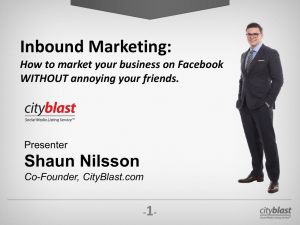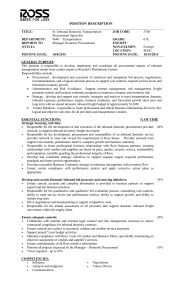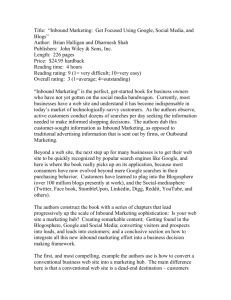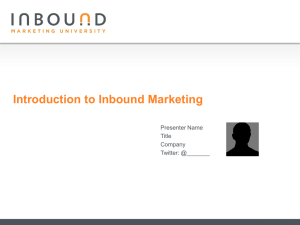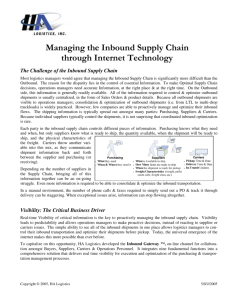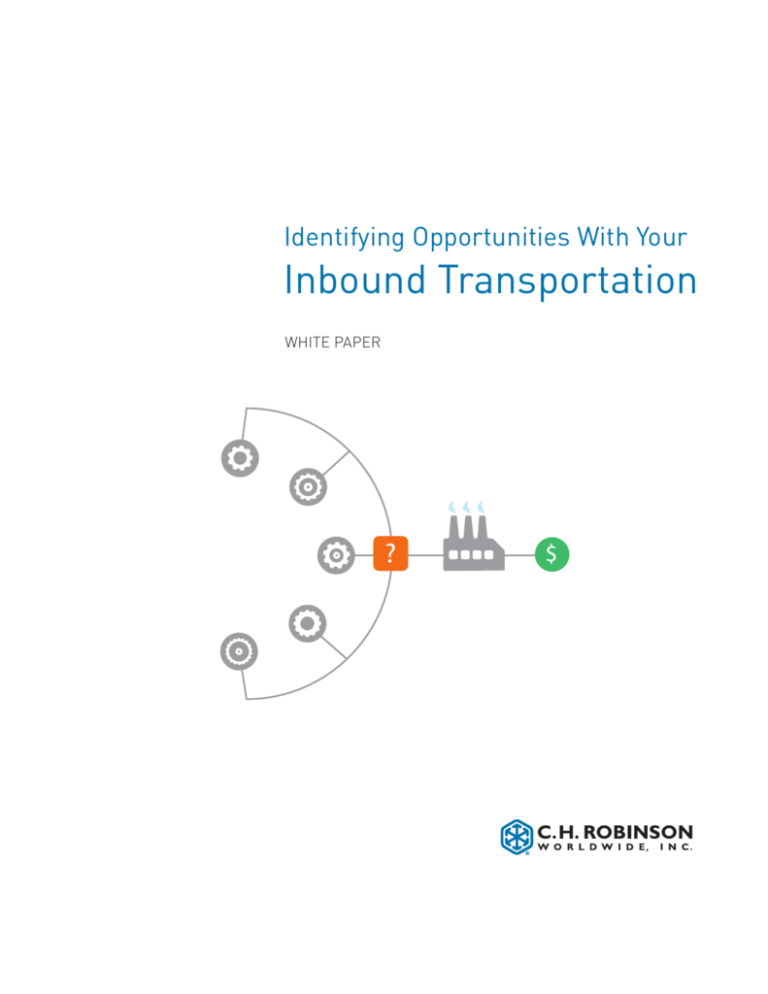
Identifying Opportunities With Your
Inbound Transportation
WHITE PAPER
?
$
$
In brief
With the right processes and visibility, companies
of any size can improve the inbound segment of the
supply chain. There are multiple components in an
inbound program. In this paper, we’ll focus on how
visibility and business processes can drive improved
savings and service.
Contents
Common inbound logistics gaps
Where you’ll find inbound savings
How to start an inbound program
Visibility and a proactive approach to managing an inbound program
Intellectual capital
Discover more opportunities in inbound logistics C.H. Robinson Worldwide, Inc. | Identifying Opportunities With Your Inbound Transportation
3
4
5
5
7
7
2
Many companies, regardless of size, have already
eliminated inefficiencies and found savings in
outbound logistics. Only a few have made the same
effort to control inbound freight from vendors,
co-packers, and suppliers.
Yet, a well-run inbound transportation program can reduce costs, improve
service, minimize delays, reduce confusion, and raise performance. It can drive
efficiencies across the entire supply chain. And many of the same process
improvements that are applied to outbound transportation to save time and
money actually work on inbound, too.
Common inbound logistics gaps
Transportation costs are affected by carrier acceptance rates, market volatility,
order patterns, and quantities. To hedge for unknown costs, suppliers often
factor in a margin of error in your delivered price for inbound product. That
makes it impossible to know how well suppliers are managing your transportation, or for you to obtain a true cost per unit.
Lack of optimization is another type of process gap. Sometimes, suppliers ship
product to get it off their own dock, not for your benefit. And unless suppliers
optimize orders and consolidate loads, they may not maximize the weight on the
trucks they send to you.
Finally, delivered pricing is sometimes structured so that any reduction the
supplier negotiates in freight rates adds to their margin. That gives the supplier
an incentive to select lowest-cost carriers, without regard to service.
C.H. Robinson Worldwide, Inc. | Identifying Opportunities With Your Inbound Transportation
3
Where you’ll find inbound savings
Inbound programs can enhance processes and achieve savings through:
• Procurement.
Carrier bidding helps identify the optimal carrier and rate. When
you add inbound lanes to outbound, you increase freight volumes, making your
business more attractive to carriers at potentially lower rates.
•O
rder optimization. Individual orders can be optimized and grouped together
across facilities to create multi-pick, single drop shipments. LTL loads from
multiple suppliers can be consolidated into a single truckload to reduce costs
and dock congestion (see illustration below).
•V
isibility. When you have a clear view of inbound inventory, it’s easier to control
asset utilization and production processes.
• Improved
on-time delivery. Carriers can be measured on load tender
acceptance, on-time performance, compliance to status updates, invoice
accuracy, and claims ratios.
•M
etrics and control processes. Improve performance by measuring supplier
compliance, product availability, on-time performance, order quantity, and
demurrage.
•A
ccurate cost allocations and pricing. When you know the true freight costs by
SKU, case, and each, costing allocations and pricing to your customer can be
more accurate.
ILLUSTRATION OF LTL CONSOLIDATION
Shipper
A
Shipper
B
Shipper
C
People,
Process,
Technology
C.H. Robinson Worldwide, Inc. | Identifying Opportunities With Your Inbound Transportation
4
How to start an inbound program
Either you or your suppliers are managing your inbound process today.
• If your suppliers select the carriers, negotiate the rates, and pay the transportation charges, you are paying a combined fee for both the transportation and
the product. The first step is to own the inbound transportation event. Consider
terms of sale and current freight allowances before creating an inbound
program. This may mean renegotiating contracts with vendors and breaking
out transportation and purchasing costs within your systems. But it is worth
the effort.
• If you currently own the transportation event, you have already delineated
between the cost of transportation and the cost of goods. Now you’re ready to
further enhance your inbound management by improving business processes.
For greater supply chain performance and cost control, you’ll need to put
proactive processes and visibility in place to ensure you have the right product
at the right location at the right time.
Visibility and a proactive approach
to managing an inbound program
The next step—often the most overlooked—is to proactively manage your
suppliers. This involves utilizing business processes and visibility to identify
issues in advance. Managing and auditing against your business processes can
be done through available technology or through a service provider.
What’s involved in a good
inbound logistics program?
With a good inbound program, you’ll have a better
understanding of the true cost of goods and
transportation rates. A solid inbound program
allows you to:
• Review vendor and supplier
business processes
• Map your own internal buyer/
purchasing processes
• Monitor vendor shipments to
verify that orders are shipping
on time
• Consolidate shipments and
optimize loads and modes
• Gain visibility to pending,
complete, and shipped inbound
orders through a single data
repository
• Report on compliance levels
of vendors and supply chain
performance
• Change terms of sale and study
freight allowances you are
currently being offered
• Receive advance notice of late
shipments to change production
schedules
• Review your business process
changes and how they can yield
real freight savings and increased
transportation performance
C.H. Robinson Worldwide, Inc. | Identifying Opportunities With Your Inbound Transportation
5
Technology gives all parties visibility to orders and expected arrival dates.
When you have visibility to inbound orders from all your suppliers and apply
optimization rationale, individual orders can be grouped across facilities and
multiple shipments going to the same origin/destination pair over several
days can be identified. Using transportation management software (TMS), you
can consolidate and ship using the most cost-effective mode and proactively
monitor the shipments in transit. As carrier and supplier compliance data is
collected and analyzed, you’ll gain new insights for driving efficiency.
Without visibility to
inbound freight and
processes, it is difficult
to identify and influence
the process gaps that
cause variability in your
supply chain.
Without visibility to inbound freight and processes, it is difficult to identify and
influence the process gaps that cause variability in your supply chain. Often, you
may have to arrange for material delivery into a production facility just in time
for manufacturing. Because most companies plan their production 48 hours
in advance, that doesn’t leave much wiggle room for late deliveries of critical
materials. With shipment visibility, you can confirm that a shipment does, in
fact, need to be expedited, and in that event, you can choose the most efficient
service for the requirements. The reasons for expediting the load can be
captured and analyzed to minimize the risk in the future.
Or, perhaps you discover you’re missing an item a few days before production
is scheduled to begin. The product was ordered, but did it ship? When? Will
it arrive on time? Where is it? Is it headed to the right facility? Is your service
consistent enough to be sure?
Without visibility, it will take many hours and phone calls to get the answers.
If the product arrives on time, the production process can proceed as planned.
But if the item you’re waiting for doesn’t arrive, you may not know it until
it’s too late to switch to another production line until the missing SKU arrives.
The result can be overstaffing, understaffing, and confusion at the dock
where the product was to be received. This scenario has both cost and
service implications.
How can you avoid overstaffing,
understaffing, and dock confusion?
Connect with vendors, suppliers, and your transportation provider through one data repository so
you can identify process gaps and duplicate process
strengths. Your solution should provide visibility to:
• Mode shifting
• Order dates
• Vendor commitments for
pickup and delivery
• Load tenders when freight
is booked
• Actual pickups and deliveries
• Status calls from the drivers
in transit
• Deviations from your plans well
before the production process
is to occur
C.H. Robinson Worldwide, Inc. | Identifying Opportunities With Your Inbound Transportation
6
Intellectual capital
A 3PL can guide you to a well-managed inbound program. They have systems
that deliver proactive information and provide a greater certainty of uninterrupted production, at little or no cost to you. In addition to the systems, they
have supply chain professionals with practical experience with inbound logistics
programs. Programs can be customized by using best practices to meet your
business needs. Frequently, this includes calling your vendors in advance to find
out whether freight is ready for pickup. If the freight is ready, the provider will
schedule a vehicle to pick up the freight and give you a delivery date.
With proactive shipping
information and greater
certainty of production
being executed as
planned, you can save
money and time.
If the freight isn’t ready as expected, your provider can note that in the system,
triggering a notification to you well before your critical receipt window. That
kind of proactive behavior enables you to work with the vendor to expedite
delivery, or to switch to a different product/SKU until the missing part arrives.
With proactive shipping information and greater certainty of production being
executed as planned, you can save money and time.
Discover more opportunities in inbound logistics
This paper presents a few of the early decisions required to begin an inbound
logistics program. You can strengthen your program by moving beyond the
basics and employing additional inbound practices:
• Compliance
• Audit processes
• Reporting strategies and metrics
• Economic order quantities
• Inventory strategies
A qualified service provider can help you choose and execute the practices that
will best enhance your inbound program.
C.H. Robinson Worldwide, Inc. | Identifying Opportunities With Your Inbound Transportation
7
About us
Founded in 1905, C.H. Robinson Worldwide, Inc. is one of the largest third party
logistics companies in the world, providing freight services, logistics outsource
solutions, fresh produce sourcing, and information services to more than 36,000
customers globally, ranging from Fortune 500 companies to small businesses in
a variety of industries.
For more information, please visit www.chrobinson.com.
14701 Charlson Road, Eden Prairie, MN 55347 | 800.323.7587 | www.chrobinson.com
Originally published in 2009. Reprinted in 2010. © 2011 C.H. Robinson Worldwide, Inc. All Rights Reserved.
C.H. Robinson Worldwide, Inc. | Identifying Opportunities With Your Inbound Transportation
8

